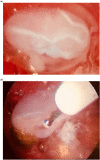Management of Non-Tubal Ectopic Pregnancies: A Single Center Experience
- PMID: 32878097
- PMCID: PMC7555978
- DOI: 10.3390/diagnostics10090652
Management of Non-Tubal Ectopic Pregnancies: A Single Center Experience
Abstract
Non-tubal ectopic pregnancies (NT-EPs) are rare but potentially life-threatening conditions. The incidence ranges are between 5-8.3% of all ectopic pregnancies. For this retrospective observational study, 16 patients with NT-EP and treated from January 2014 to May 2020 were recruited. Demographic details, symptoms, Beta human chorionic gonadotrophin (β-hCG) levels, ultrasound findings, management and treatment outcomes were presented. In hemodynamically stable patients, diagnosis was made using ultrasounds and β-hCG levels. Laparoscopy was essential to identify and remove the ectopic pregnancy in clinical unstable patients. A radical laparoscopic approach was chosen in one case of cervical pregnancy diagnosed late in the first trimester. Medical treatment and minimally invasive procedure, alone or combined, resulted in effective strategies in asymptomatic women with an early diagnosis of NT-EP. We report cases of cervical pregnancies successfully treated by hysteroscopy alone or combined with medical treatment, the first case of scar pregnancy treated by mini-reseptoscope and curettage and the fifth case of interstitial pregnancy treated with Methotrexate and Mifepristone. In this manuscript we report a single center experience in the management of NT-EPs with the aim of outlining the importance of the early diagnosis for a minimally invasive treatment in order to reduce maternal morbidity and mortality and preserve future fertility.
Keywords: ectopic non-tubal pregnancy; fertility sparing; hysteroscopy; laparoscopy.
Conflict of interest statement
The authors declare no conflict of interest.
Figures








Similar articles
-
Ectopic pregnancy.Clin Obstet Gynecol. 1985 Jun;28(2):365-74. doi: 10.1097/00003081-198528020-00014. Clin Obstet Gynecol. 1985. PMID: 2410172
-
A 20 year experience in the management of non-tubal ectopic pregnancies in a tertiary hospital - a retrospective review.Reprod Health. 2024 Jul 2;21(1):95. doi: 10.1186/s12978-024-01838-6. Reprod Health. 2024. PMID: 38956582 Free PMC article.
-
Interstitial Pregnancy Treated with Mifepristone and Methotrexate with High Serum β-hCG Level in a Patient Wishing to Preserve Fertility: Time to Define Standardized Criteria for Medical/Surgical Therapy?Int J Environ Res Public Health. 2022 Sep 12;19(18):11464. doi: 10.3390/ijerph191811464. Int J Environ Res Public Health. 2022. PMID: 36141736 Free PMC article.
-
Methotrexate vs placebo in early tubal ectopic pregnancy: a multi- centre double-blind randomised trial.Rev Recent Clin Trials. 2012 Aug;7(3):238-43. doi: 10.2174/157488712802281321. Rev Recent Clin Trials. 2012. PMID: 22540910 Review.
-
Medical therapy (methotrexate and mifepristone) alone or in combination with another type of therapy for the management of cervical or interstitial ectopic pregnancy.Eur J Obstet Gynecol Reprod Biol. 2012 Nov;165(1):77-81. doi: 10.1016/j.ejogrb.2012.06.024. Epub 2012 Jul 7. Eur J Obstet Gynecol Reprod Biol. 2012. PMID: 22771188 Review.
Cited by
-
Spontaneous Bladder Rupture after Normal Vaginal Delivery: Description of a Rare Complication and Systematic Review of the Literature.Diagnostics (Basel). 2021 Oct 13;11(10):1885. doi: 10.3390/diagnostics11101885. Diagnostics (Basel). 2021. PMID: 34679583 Free PMC article. Review.
-
Intra-amniotic and systemic administration of methotrexate with concomitant surgical evacuation of 11 + 5 weeks cervical ectopic pregnancy: a case report.BMC Pregnancy Childbirth. 2023 Jul 1;23(1):486. doi: 10.1186/s12884-023-05794-0. BMC Pregnancy Childbirth. 2023. PMID: 37393228 Free PMC article.
-
The Rare, Unexpected Condition of a Twisted Leiomyoma in Mayer-Rokitansky-Küster-Hauser (MRKH) Syndrome: Etiopathogenesis, Diagnosis and Management. Our Experience and Narrative Review of the Literature.Int J Environ Res Public Health. 2021 May 31;18(11):5895. doi: 10.3390/ijerph18115895. Int J Environ Res Public Health. 2021. PMID: 34072739 Free PMC article. Review.
-
Pelvic mass, ascites, hydrothorax: a malignant or benign condition? Meigs syndrome with high levels of CA 125.Prz Menopauzalny. 2021 Jun;20(2):103-107. doi: 10.5114/pm.2021.106100. Epub 2021 May 25. Prz Menopauzalny. 2021. PMID: 34321989 Free PMC article.
-
Persistent cornual pregnancy mimicking uterine arteriovenous malformation: a case report.BMC Womens Health. 2023 Jun 16;23(1):314. doi: 10.1186/s12905-023-02450-9. BMC Womens Health. 2023. PMID: 37328873 Free PMC article.
References
-
- Prameela R., Dev S. Cervical ectopic pregnancy: 10 year experience at tertiary care hospital and current literature review. Int. J. Reprod. Contracept. Obstet. Gynecol. 2016 doi: 10.18203/2320-1770.ijrcog20160575. - DOI
LinkOut - more resources
Full Text Sources
Research Materials

